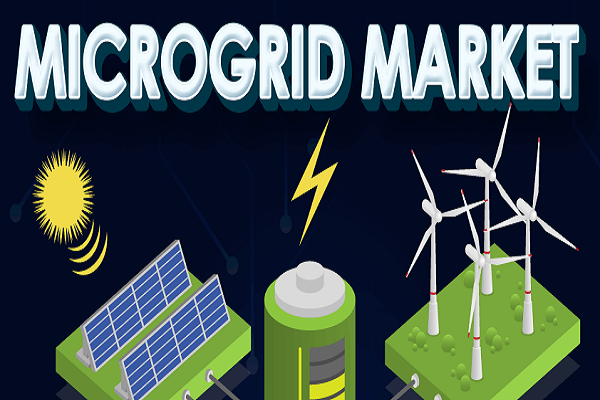Global Microgrid market size was USD 71.62 billion in 2023 and the market is projected to touch USD 243.25 billion by 2032, at a CAGR of 14.55% during the forecast period. A microgrid is a small, localized power system that can function independently or in tandem with the main electrical grid. It often incorporates a variety of energy sources such as solar panels, wind turbines, batteries, and generators, as well as the appropriate control systems for efficient power management and distribution. Microgrids are intended to provide dependable, sustainable, and resilient energy solutions, especially in distant places or during power outages.
The global microgrid market is expanding rapidly due to rising demand for reliable and sustainable energy, an increase in power outages, and developments in renewable energy technology. North America dominates the industry, owing to significant investments and favourable government policies. Asia-Pacific is also an important player, with rising urbanization and industrialization driving demand. The market is characterized by the growing adoption of renewable energy sources, integration of smart grid technologies, and the need for energy security and independence. Key sectors driving this growth include commercial and industrial establishments, remote communities, and military bases.
Global Microgrid report scope and segmentation.
| Report Attribute | Details |
| Base Year | 2023 |
| Forecast Years | 2024 – 2032 |
| Estimated Market Value (2023) | USD 71.62 Billion |
| Projected Market Value (2032) | USD 243.25 Billion |
| Segments Covered | By Capacity, By Power Source, By Application, & By Region. |
| Forecast Units | Value (USD Million or Billion) |
| Quantitative Units | Revenue in USD million/billion and CAGR from 2024 to 2032. |
| Regions Covered | North America, Europe, Asia Pacific, Latin America, and Middle East & Africa. |
| Countries Covered | U.S., Canada, Mexico, U.K., Germany, France, Italy, Spain, China, India, Japan, South Korea, Australia, Brazil, Argentina, GCC Countries, and South Africa, among others. |
Global Microgrid dynamics
One of the key reasons is the growing demand for continuous power supply in important infrastructure including hospitals, military sites, and data centers, where power outages can have serious effects. Furthermore, the push for renewable energy integration and carbon footprint reductions is driving the use of microgrids, which may efficiently incorporate renewable sources such as solar and wind power. Technological improvements in energy storage and smart grid technologies play a vital role in boosting the efficiency and reliability of microgrids.
On the other hand, the market faces challenges, such as high initial capital costs and complex regulatory frameworks, which can hinder widespread adoption. The integration of diverse energy sources and technologies into a cohesive system requires significant investment and sophisticated management. Moreover, regulatory and policy barriers in different regions can create uncertainty and slow down market growth. However, these challenges are gradually being addressed through supportive government policies, incentives for renewable energy projects, and advancements in technology that reduce costs and improve system integration.
Global Microgrid drivers
Rising Demand for Reliable and Sustainable Energy
Reliable energy is crucial in industries such as healthcare, defense, and data management, where power interruptions can have disastrous implications. Microgrids provide a dependable solution by supplying localized power that may run independently of the main grid, assuring continuous energy supply even during grid outages. Furthermore, the increased emphasis on sustainability encourages the use of renewable energy sources like solar and wind in microgrids. These systems can efficiently incorporate renewable energy, reducing reliance on fossil fuels and minimizing carbon emissions, therefore aligning with global efforts to address climate change.
Advancements in Technology
Technological advances in energy storage, such as batteries and smart grid systems, are dramatically improving microgrid operation and efficiency. Energy storage technologies allow microgrids to store excess energy created during peak production periods and use it during low production periods, maintaining a consistent and uninterrupted energy supply. Furthermore, smart grid technologies provide better control and management of energy distribution within microgrids, resulting in increased energy efficiency and reliability. These technical advancements make microgrids more efficient and cost-effective, driving their adoption in diverse sectors.
- Restraints:
High Initial Capital Costs
The initial investment required to set up a microgrid is substantial, covering the costs of renewable energy sources, energy storage systems, and advanced control technologies. This high capital expenditure can be a significant barrier, particularly for small and medium-sized enterprises or communities with limited financial resources. While the operational savings and long-term benefits of microgrids are clear, the upfront costs can deter potential adopters and slow market growth.
Regulatory and Policy Challenges
The regulatory environment for microgrids can be complex and inconsistent between areas. Regulatory frameworks frequently lag behind technology improvements, generating ambiguity and possibly legal barriers to microgrid deployment. In some cases, legislation may not effectively support the integration of microgrids into existing energy infrastructure, or there may be inadequate incentives to encourage their use. Navigating these regulatory difficulties demands significant work and might delay projects, therefore limiting market growth.
- Opportunities:
Decreasing Costs of Renewable Energy Technologies
The costs of renewable energy technologies, such as solar panels and wind turbines, have been steadily decreasing due to technological advancements and economies of scale. This trend is making microgrids more financially viable and attractive to a broader range of users. Lower costs reduce the financial barriers to entry, allowing more communities, businesses, and institutions to invest in microgrids. Furthermore, the declining cost of energy storage systems enhances the appeal of microgrids by improving their efficiency and reliability, creating substantial growth opportunities in the market.
- Segment Overview
The microgrid market is segmented by capacity into less than 5 MW, 5 MW – 10 MW, 10 MW – 20 MW, 20 MW – 50 MW, and above 50 MW. Microgrids with a capacity of less than 5 MW are typically used in small-scale applications such as residential complexes, small commercial setups, or remote communities with limited energy needs. These microgrids are often powered by renewable energy sources combined with energy storage systems to ensure reliability. The 5 MW – 10 MW and 10 MW – 20 MW segments cater to medium-sized installations like educational institutions, mid-sized commercial and industrial facilities, and larger remote communities. These capacities are suitable for providing reliable power and integrating multiple renewable sources. Microgrids with a capacity of 20 MW – 50 MW are used in larger commercial and industrial setups, utility distribution networks, and military bases, providing a robust and resilient energy solution. The above 50 MW segment represents large-scale installations, often encompassing multiple interconnected microgrids serving extensive industrial complexes, large university campuses, or major utility grids, ensuring high energy security and efficiency.
The segmentation by power source includes diesel generators, natural gas, solar PV, and combined heat and power (CHP) systems. Diesel generators are a traditional and widely used power source for microgrids, providing reliable backup power, especially in remote areas where other energy sources may be unavailable. However, they are being gradually replaced by cleaner alternatives due to environmental concerns. Natural gas generators offer a cleaner and more efficient alternative to diesel, providing a reliable power source with lower emissions. Solar PV systems are increasingly popular in microgrids due to the decreasing costs of solar technology and their environmental benefits, allowing for sustainable energy production. Combined heat and power (CHP) systems are efficient as they generate electricity and utilize the waste heat for heating purposes, making them ideal for commercial and industrial applications that require both power and heat. The integration of these diverse power sources within microgrids ensures flexibility, reliability, and sustainability.
Global Microgrid Overview by Region
North America dominates the market, owing to significant investments, a favourable legislative framework, and a strong emphasis on renewable energy. The United States, in example, has various microgrid initiatives aiming at improving energy resilience and sustainability, which are aided by federal and state incentives. The presence of significant industry players, as well as improvements in smart grid technology, help to strengthen the region’s market supremacy. Canada also contributes to the regional market, focusing on isolated and indigenous populations and using microgrids to deliver dependable and sustainable energy solutions.
Rapid urbanization, industrialization, and rising energy demand are major factors driving the microgrid industry in Asia-Pacific. Countries like China, India, and Japan are investing heavily in microgrid technologies to address energy security and integrate renewable energy sources. China leads in the deployment of renewable energy microgrids, supported by government policies aimed at reducing carbon emissions and promoting sustainable development. India is focusing on rural electrification and improving grid reliability, with microgrids playing a crucial role. Japan, with its advanced technological capabilities, is leveraging microgrids for disaster resilience and energy efficiency.
Global Microgrid market competitive landscape
Major companies such as Siemens AG, General Electric, Schneider Electric, and ABB dominate the industry due to their extensive portfolios and technological expertise. To sustain a competitive advantage, these organizations rely on their global presence, strong R&D capabilities, and comprehensive service offerings. They are actively developing advanced microgrid solutions, incorporating renewable energy sources, and improving energy storage and management systems to meet the changing demands of various industries.
In addition to these behemoths, there are other rising competitors and specialist enterprises that cater to specific niches of the microgrid industry. Companies like Tesla, with its revolutionary energy storage solutions, and Bloom Energy, famed for its fuel cell technology, are making tremendous progress. These companies often collaborate with local utilities, governments, and private sector clients to deploy customized microgrid solutions tailored to specific regional and application needs. The competitive landscape is further intensified by the involvement of IT and technology firms such as IBM and Honeywell, which are integrating advanced software and analytics into microgrid management, enhancing efficiency and reliability.
Global Microgrid Recent Developments
- In March 2023, ABB formed a strategic partnership with Direct Energy Partners (DEP), a start-up that leverages digital technology to promote the adoption of Direct Current (DC) microgrids. As part of this partnership, ABB’s venture capital arm, ABB Technology Ventures (ATV), is making a minority investment in Direct Energy Partners. The financial terms of this investment have not been disclosed.
- In Aug 2022, TP Renewable Microgrid Limited (TPRMG), a wholly owned subsidiary of Tata Power, and Small Industries Development Bank of India (SIDBI) have collaborated to introduce an innovative program aimed at establishing 1,000 green energy enterprises nationwide. This initiative aligns with the Government of India’s vision of Atmanirbhar Bharat, fostering sustainable entrepreneurship models across the country and empowering rural entrepreneurs. Under this partnership, SIDBI will offer entrepreneurs the “Go REsponsive, ENterprise incentive (GREENi)” upon completion of capacity building activities organized by TPRMG.
- In March 2024, Schneider Electric and Mainspring Energy have unveiled a collaborative effort during the annual CERAWeek Conference. They aim to introduce an innovative hybrid-energy technology merging Schneider Electric’s EcoStruxure Microgrid Solution and turn-key design-build services with Mainspring’s pioneering Linear Generator. This partnership offers a unique blend of power and fuel-flexibility, along with enhanced energy resiliency tailored for commercial and industrial customers.
Scope of global Microgrid report
Global Microgrid report segmentation
| ATTRIBUTE | DETAILS |
| By Capacity | Less than 5 MW5 MW – 10 MW10 MW – 20 MW20 MW – 50 MWAbove 50 MW |
| By Power Source | Diesel GeneratorsNatural GasSolar PVCHP |
| By Application | Educational InstitutesRemote AreasMilitaryUtility DistributionCommercial & IndustrialOthers |
| Customization Scope | Available upon request |
| Pricing | Available upon request |
Table of Contents
- Market Scope and Research Methodology
- Market Segmentation & Scope
- Market Definition
- Research Methodology
- Our Internal Database
- Paid Sources Database
- Secondary Sources & Third-Party Perspectives
- Primary Research, Experts Interviews and Market Surveys
- Research Objective
- Data Validation & Publishing
- Executive Summary
- Market Outlook
- Segmental Analysis
- Microgrid Market Dynamics
- Market Introduction
- Market Drivers
- Rising Demand for Reliable and Sustainable Energy
- Advancements in Technology
- Market Restraints
- High Initial Capital Costs
- Regulatory and Policy Challenges
- Industry Challenges
- Industry Opportunities
- Regulatory Frameworks
- Patent Trends
- Covid-19 Impact Analysis
- Market Strategic Analysis
- Industry Analysis – Porter’s
- Supplier Power
- Buyer Power
- Substitution Threat
- Threat from New Entrant
- Competitive Rivalry
- PESTEL Analysis
- Consumer behaviour analysis
- Consumer response to the product
- Factors affecting buying decision
- Other recommendations
- Industry Analysis – Porter’s
- Microgrid Market: Capacity Estimates & Trend Analysis
- Capacity Movement Analysis & Market Share, 2023 & 2032
- Less than 5 MW
- Market estimates and forecast, 2024-2032, (USD Billion)
- 5 MW – 10 MW
- Market estimates and forecast, 2024-2032, (USD Billion)
- 10 MW – 20 MW
- Market estimates and forecast, 2024-2032, (USD Billion)
- 20 MW – 50 MW
- Market estimates and forecast, 2024-2032, (USD Billion)
- Above 50 MW
- Market estimates and forecast, 2024-2032, (USD Billion)
- Microgrid Market: Power Source Estimates & Trend Analysis
- Power Source Movement Analysis & Market Share, 2023 & 2032
- Diesel Generators
- Market estimates and forecast, 2024-2032, (USD Billion)
- Natural Gas
- Market estimates and forecast, 2024-2032, (USD Billion)
- Solar PV
- Market estimates and forecast, 2024-2032, (USD Billion)
- CHP
- Market estimates and forecast, 2024-2032, (USD Billion)
- Microgrid Market: Application Estimates & Trend Analysis
- Application Movement Analysis & Market Share, 2023 & 2032
- Educational Institutes
- Market estimates and forecast, 2024-2032, (USD Billion)
- Remote Areas
- Market estimates and forecast, 2024-2032, (USD Billion)
- Military
- Market estimates and forecast, 2024-2032, (USD Billion)
- Utility Distribution
- Market estimates and forecast, 2024-2032, (USD Billion)
- Market estimates and forecast, 2024-2032, (USD Billion)
- Commercial & Industrial
- Market estimates and forecast, 2024-2032, (USD Billion)
- Others
- Market estimates and forecast, 2024-2032, (USD Billion)
- Microgrid Market: Regional Estimates & Trend Analysis
- Regional Movement Analysis & Market Share, 2023 & 2032
- North America
- Market estimates and forecast, 2024-2032, (USD Billion)
- Market estimates and forecast, by Capacity, 2024-2032, (USD Billion)
- Market estimates and forecast, by Power Source, 2024-2032, (USD Billion)
- Market estimates and forecast, by Application, 2024-2032, (USD Billion)
- U.S.
- Market estimates and forecast, 2024-2032, (USD Billion)
- Market estimates and forecast, by Capacity, 2024-2032, (USD Billion)
- Market estimates and forecast, by Power Source, 2024-2032, (USD Billion)
- Market estimates and forecast, by Application, 2024-2032, (USD Billion)
- Canada
- Market estimates and forecast, 2024-2032, (USD Billion)
- Market estimates and forecast, by Capacity, 2024-2032, (USD Billion)
- Market estimates and forecast, by Power Source, 2024-2032, (USD Billion)
- Market estimates and forecast, by Application, 2024-2032, (USD Billion)
- Europe
- Market estimates and forecast, 2024-2032, (USD Billion)
- Market estimates and forecast, by Capacity, 2024-2032, (USD Billion)
- Market estimates and forecast, by Power Source, 2024-2032, (USD Billion)
- Market estimates and forecast, by Application, 2024-2032, (USD Billion)
- Germany
- Market estimates and forecast, 2024-2032, (USD Billion)
- Market estimates and forecast, by Capacity, 2024-2032, (USD Billion)
- Market estimates and forecast, by Power Source, 2024-2032, (USD Billion)
- Market estimates and forecast, by Application, 2024-2032, (USD Billion)
- UK
- Market estimates and forecast, 2024-2032, (USD Billion)
- Market estimates and forecast, by Capacity, 2024-2032, (USD Billion)
- Market estimates and forecast, by Power Source, 2024-2032, (USD Billion)
- Market estimates and forecast, by Application, 2024-2032, (USD Billion)
- France
- Market estimates and forecast, 2024-2032, (USD Billion)
- Market estimates and forecast, by Capacity, 2024-2032, (USD Billion)
- Market estimates and forecast, by Power Source, 2024-2032, (USD Billion)
- Market estimates and forecast, by Application, 2024-2032, (USD Billion)
- Spain
- Market estimates and forecast, 2024-2032, (USD Billion)
- Market estimates and forecast, by Capacity, 2024-2032, (USD Billion)
- Market estimates and forecast, by Power Source, 2024-2032, (USD Billion)
- Market estimates and forecast, by Application, 2024-2032, (USD Billion)
- Rest of Europe
- Market estimates and forecast, 2024-2032, (USD Billion)
- Market estimates and forecast, by Capacity, 2024-2032, (USD Billion)
- Market estimates and forecast, by Power Source, 2024-2032, (USD Billion)
- Market estimates and forecast, by Application, 2024-2032, (USD Billion)
- Asia Pacific
- Market estimates and forecast, 2024-2032, (USD Billion)
- Market estimates and forecast, by Capacity, 2024-2032, (USD Billion)
- Market estimates and forecast, by Power Source, 2024-2032, (USD Billion)
- Market estimates and forecast, by Application, 2024-2032, (USD Billion)
- China
- Market estimates and forecast, 2024-2032, (USD Billion)
- Market estimates and forecast, by Capacity, 2024-2032, (USD Billion)
- Market estimates and forecast, by Power Source, 2024-2032, (USD Billion)
- Market estimates and forecast, by Application, 2024-2032, (USD Billion)
- India
- Market estimates and forecast, 2024-2032, (USD Billion)
- Market estimates and forecast, by Capacity, 2024-2032, (USD Billion)
- Market estimates and forecast, by Power Source, 2024-2032, (USD Billion)
- Market estimates and forecast, by Application, 2024-2032, (USD Billion)
- Japan
- Market estimates and forecast, 2024-2032, (USD Billion)
- Market estimates and forecast, by Capacity, 2024-2032, (USD Billion)
- Market estimates and forecast, by Power Source, 2024-2032, (USD Billion)
- Market estimates and forecast, by Application, 2024-2032, (USD Billion)
- South Korea
- Market estimates and forecast, 2024-2032, (USD Billion)
- Market estimates and forecast, by Capacity, 2024-2032, (USD Billion)
- Market estimates and forecast, by Power Source, 2024-2032, (USD Billion)
- Market estimates and forecast, by Application, 2024-2032, (USD Billion)
- Australia
- Market estimates and forecast, 2024-2032, (USD Billion)
- Market estimates and forecast, by Capacity, 2024-2032, (USD Billion)
- Market estimates and forecast, by Power Source, 2024-2032, (USD Billion)
- Market estimates and forecast, by Application, 2024-2032, (USD Billion)
- Southeast Asia
- Market estimates and forecast, 2024-2032, (USD Billion)
- Market estimates and forecast, by Capacity, 2024-2032, (USD Billion)
- Market estimates and forecast, by Power Source, 2024-2032, (USD Billion)
- Market estimates and forecast, by Application, 2024-2032, (USD Billion)
- Rest of Asia Pacific
- Market estimates and forecast, 2024-2032, (USD Billion)
- Market estimates and forecast, by Capacity, 2024-2032, (USD Billion)
- Market estimates and forecast, by Power Source, 2024-2032, (USD Billion)
- Market estimates and forecast, by Application, 2024-2032, (USD Billion)
- Middle East & Africa
- Market estimates and forecast, 2024-2032, (USD Billion)
- Market estimates and forecast, by Capacity, 2024-2032, (USD Billion)
- Market estimates and forecast, by Power Source, 2024-2032, (USD Billion)
- Market estimates and forecast, by Application, 2024-2032, (USD Billion)
- GCC
- Market estimates and forecast, 2024-2032, (USD Billion)
- Market estimates and forecast, by Capacity, 2024-2032, (USD Billion)
- Market estimates and forecast, by Power Source, 2024-2032, (USD Billion)
- Market estimates and forecast, by Application, 2024-2032, (USD Billion)
- Turkey
- Market estimates and forecast, 2024-2032, (USD Billion)
- Market estimates and forecast, by Capacity, 2024-2032, (USD Billion)
- Market estimates and forecast, by Power Source, 2024-2032, (USD Billion)
- Market estimates and forecast, by Application, 2024-2032, (USD Billion)
- Africa
- Market estimates and forecast, 2024-2032, (USD Billion)
- Market estimates and forecast, by Capacity, 2024-2032, (USD Billion)
- Market estimates and forecast, by Power Source, 2024-2032, (USD Billion)
- Market estimates and forecast, by Application, 2024-2032, (USD Billion)
- Rest of MEA
- Market estimates and forecast, 2024-2032, (USD Billion)
- Market estimates and forecast, by Capacity, 2024-2032, (USD Billion)
- Market estimates and forecast, by Power Source, 2024-2032, (USD Billion)
- Market estimates and forecast, by Application, 2024-2032, (USD Billion)
- Latin America
- Market estimates and forecast, 2024-2032, (USD Billion)
- Market estimates and forecast, by Capacity, 2024-2032, (USD Billion)
- Market estimates and forecast, by Power Source, 2024-2032, (USD Billion)
- Market estimates and forecast, by Application, 2024-2032, (USD Billion)
- Brazil
- Market estimates and forecast, 2024-2032, (USD Billion)
- Market estimates and forecast, by Capacity, 2024-2032, (USD Billion)
- Market estimates and forecast, by Power Source, 2024-2032, (USD Billion)
- Market estimates and forecast, by Application, 2024-2032, (USD Billion)
- Mexico
- Market estimates and forecast, 2024-2032, (USD Billion)
- Market estimates and forecast, by Capacity, 2024-2032, (USD Billion)
- Market estimates and forecast, by Power Source, 2024-2032, (USD Billion)
- Market estimates and forecast, by Application, 2024-2032, (USD Billion)
- Argentina
- Market estimates and forecast, 2024-2032, (USD Billion)
- Market estimates and forecast, by Capacity, 2024-2032, (USD Billion)
- Market estimates and forecast, by Power Source, 2024-2032, (USD Billion)
- Market estimates and forecast, by Application, 2024-2032, (USD Billion)
- Rest of Latin America
- Market estimates and forecast, 2024-2032, (USD Billion)
- Market estimates and forecast, by Capacity, 2024-2032, (USD Billion)
- Market estimates and forecast, by Power Source, 2024-2032, (USD Billion)
- Market estimates and forecast, by Application, 2024-2032, (USD Billion)
- Competitive Analysis
- Key global players, recent developments & their impact on the industry
- Key Company/Competition Categorization (Key innovators, Market leaders, Emerging players)
- Vendor Landscape
- Key company market share analysis, 2021
- Company Profiles
- Anarbic
- Company Overview
- Financial Analysis
- Product Benchmarking
- Key development
- Business Strategy
- SWOT Analysis
- Eaton Corp.
- Company Overview
- Financial Analysis
- Product Benchmarking
- Key development
- Business Strategy
- SWOT Analysis
- Exelon
- Company Overview
- Financial Analysis
- Product Benchmarking
- Key development
- Business Strategy
- SWOT Analysis
- General Electric
- Company Overview
- Financial Analysis
- Product Benchmarking
- Key development
- Business Strategy
- SWOT Analysis
- Honeywell International
- Company Overview
- Financial Analysis
- Product Benchmarking
- Key development
- Business Strategy
- SWOT Analysis
- NRG International
- Company Overview
- Financial Analysis
- Product Benchmarking
- Key development
- Business Strategy
- SWOT Analysis
- Northern Power
- Company Overview
- Financial Analysis
- Product Benchmarking
- Key development
- Business Strategy
- SWOT Analysis
- Pareto
- Company Overview
- Financial Analysis
- Product Benchmarking
- Key development
- Business Strategy
- SWOT Analysis
- Siemens AG
- Company Overview
- Financial Analysis
- Product Benchmarking
- Key development
- Business Strategy
- SWOT Analysis
- Spirae
- Company Overview
- Financial Analysis
- Product Benchmarking
- Key development
- Business Strategy
- SWOT Analysis
- Viridity
- Company Overview
- Financial Analysis
- Product Benchmarking
- Key development
- Business Strategy
- SWOT Analysis
- ABB
- Company Overview
- Financial Analysis
- Product Benchmarking
- Key development
- Business Strategy
- SWOT Analysis
- Anarbic
Contact Us:
Mob : +91 9319642100
Noida One Tower Sec 62 Noida 201301
Sales : sales@organicmarketresearch.com
Website : https://www.organicmarketresearch.com















